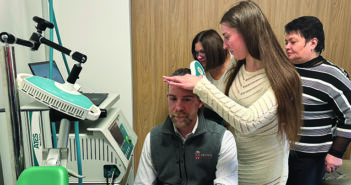Scientific communication made simple…
There are many avenues that lead Brown students to careers in research. For Chibuikem Nwizu ’15 MD’25 PhD’25, that avenue was cartoons. Specifically, it was short animated videos called SciToons, created by a group of students and faculty as a fun way to communicate scientific concepts.
The idea for SciToons first came to Oludurotimi Adetunji, PhD, associate dean of the college for undergraduate research and inclusive science and adjunct assistant professor of physics, at an American Physical Science conference. After scientists presented their research, reporters lined up to speak with them about their findings.
But no one wanted to talk with the journalists, for fear of being misquoted or misunderstood.
“That got me thinking that there’s got to be a better approach to getting the public excited about the research we do broadly as scientists,” Adetunji says.
He wanted to create a compelling way to share scientific research with a non-scientific audience. And he knew kids and adults love animation. “I decided, maybe there’s got to be an interaction between animation, storytelling, and science. What does that look like?” he says.
In 2011, Adetunji launched his first cartoon as an experiment. A team of students, half STEM and half non-STEM, produced a video about geology in collaboration with Jan Tullis, PhD, professor emerita of geological sciences. They got good feedback from educators and the general public.
But it took two years before the group released another cartoon. Meanwhile, Adetunji worked to formalize SciToons, which combines art, animation, high-quality multimedia composition, and storytelling. He recruited students interested in research and communications.
To make sure the science is clear, the team working on a project will present it to the whole group to solicit feedback. Each video script can go through five to 12 drafts. “Each draft gets cleaner and cleaner and simpler and simpler,” Nwizu says.After the script is finalized, the team moves into storyboarding and then animation, and hires a voiceover artist to narrate. Each four- to five-minute video can take eight months to a year to produce. It’s time consuming, but also immensely rewarding. Nwizu says making SciToons gave him many important skills, like “being able to communicate an idea,” which is invaluable as he begins grant writing.
The group has made more than 30 cartoons on topics ranging from stroke to data visualization to climate change, and been featured by the National Academy of Sciences, FermiLab, DARPA, and the NIH National DNA Day. Former SciTooners work at places like Ted-Ed and The Atlantic; Adetunji says they credit SciToons with giving them the necessary experience to work in communications.
With more than one million views on YouTube, SciToons is just
getting started.




